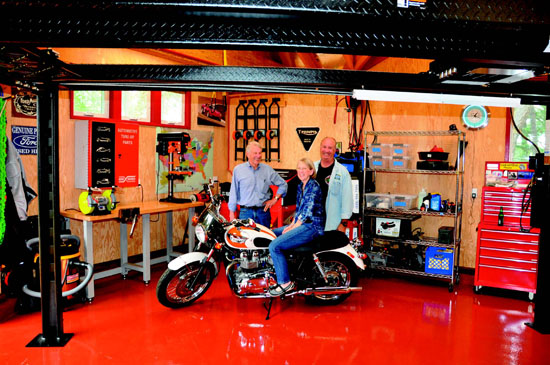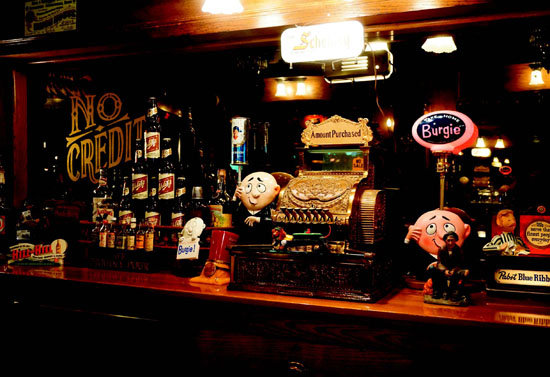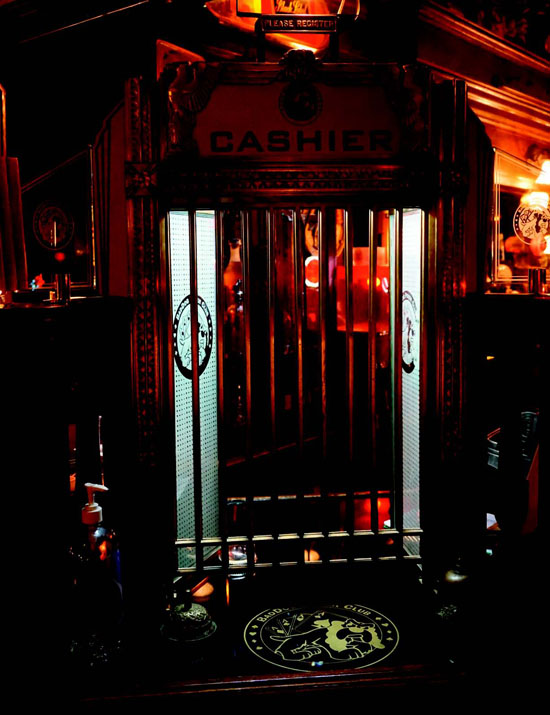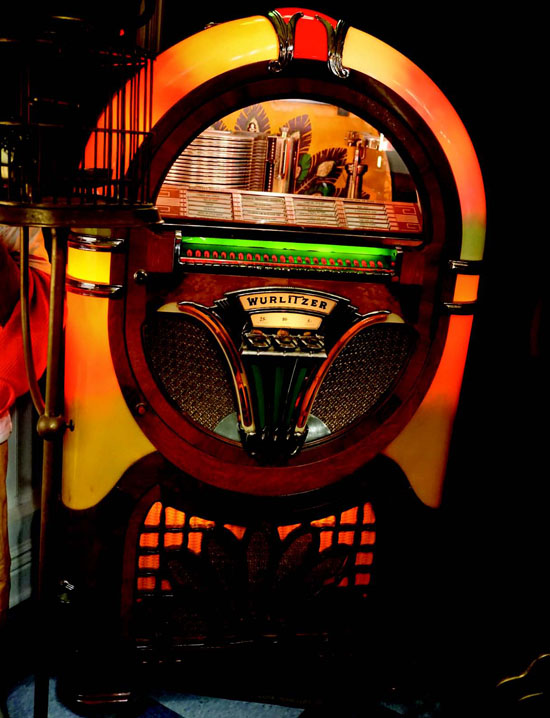 | | | Sev and Margie Marsted toured the garage of Hays Englehart (on right). Photo Andy?Scheck | | | | | | Garage, noun: a building or shed for housing a motor vehicle or vehicles - a humble definition, unless the structure has been reimagined. Lafayette Community Foundation's Nov. 1 fundraising tour gave Lamorindans an inside look at several unique garage sites. For those who missed out, here is a recap of three revamped spaces.
 The Birdhouse:
The Birdhouse:
 Hays Englehart, a self-proclaimed gearhead geek is delighted to discuss his new 700-square-foot custom-built garage, saying it was "built like a fine watch."
Hays Englehart, a self-proclaimed gearhead geek is delighted to discuss his new 700-square-foot custom-built garage, saying it was "built like a fine watch."
 "This is not a shed," he says emphatically.
"This is not a shed," he says emphatically.
 His granddaughter nicknamed the garage "The Birdhouse," referencing the 1966 Thunderbird Englehart stores there. He also has a Triumph Bonneville motorcycle, vintage blue and silver Honda mini trail bike and an award-winning 1958 balloon tire Columbia bicycle. This is a second garage, which blends in with the existing home and allows Englehart's wife to park her car inside and off the street.
His granddaughter nicknamed the garage "The Birdhouse," referencing the 1966 Thunderbird Englehart stores there. He also has a Triumph Bonneville motorcycle, vintage blue and silver Honda mini trail bike and an award-winning 1958 balloon tire Columbia bicycle. This is a second garage, which blends in with the existing home and allows Englehart's wife to park her car inside and off the street.
 Englehart chose Stevenson Construction for the four-month project, and praised his neighbors for being "so cool" during the work. Although elegant, the garage is definitely not fragile. "The foundation alone is four-foot-thick concrete," he explains, with rebar-reinforced piers. The 14-feet ceilings allow clearance for the four-post car lift. Each overhead beam supports a 1,000-pound load. The walls are covered in 5/8 plywood, and every third 2-by-2 stud was upgraded to a 4-by-4.
Englehart chose Stevenson Construction for the four-month project, and praised his neighbors for being "so cool" during the work. Although elegant, the garage is definitely not fragile. "The foundation alone is four-foot-thick concrete," he explains, with rebar-reinforced piers. The 14-feet ceilings allow clearance for the four-post car lift. Each overhead beam supports a 1,000-pound load. The walls are covered in 5/8 plywood, and every third 2-by-2 stud was upgraded to a 4-by-4.
 Englehart says if there is a "big shake," this is where he wants to be. The site has a sandblast cabinet and parts tank for motor work and 220 amp electrical services. The lighting is all LED. Englehart designed and installed his air compressor system, which he built using PVC schedule 40 pipe. He jokes he had the concrete floor sealed with Epoxy and colored dark red "to hide the blood."
Englehart says if there is a "big shake," this is where he wants to be. The site has a sandblast cabinet and parts tank for motor work and 220 amp electrical services. The lighting is all LED. Englehart designed and installed his air compressor system, which he built using PVC schedule 40 pipe. He jokes he had the concrete floor sealed with Epoxy and colored dark red "to hide the blood."
 "Every house I've ever owned I've wanted a garage like this," he says. The garage may have been clean on show day, but Englehart cannot wait to get his hands dirty. He plans to pull the T-bird's engine and transmission immediately.
"Every house I've ever owned I've wanted a garage like this," he says. The garage may have been clean on show day, but Englehart cannot wait to get his hands dirty. He plans to pull the T-bird's engine and transmission immediately.
 Vintage Saloon:
Vintage Saloon:
 It is almost always casino night for Terry and Nancy Engel. Truth be told, the couple agrees they spend more time in their four-car bay than in any other room in the house. And why not? Engel and his wife have transformed the space so convincingly that a newcomer's jaw drops when first stepping inside.
It is almost always casino night for Terry and Nancy Engel. Truth be told, the couple agrees they spend more time in their four-car bay than in any other room in the house. And why not? Engel and his wife have transformed the space so convincingly that a newcomer's jaw drops when first stepping inside.
 The heavily ornate red and black colors of the drapes and walls, casino carpeting, poker tables and a vintage 1890s full length bar are the show stoppers in a lounge filled with memorabilia from Reno's old Harold's Club.
The heavily ornate red and black colors of the drapes and walls, casino carpeting, poker tables and a vintage 1890s full length bar are the show stoppers in a lounge filled with memorabilia from Reno's old Harold's Club.
 Terry Engel jokingly calls their space "a den of alcohol, tobacco and gambling."
Terry Engel jokingly calls their space "a den of alcohol, tobacco and gambling."
 "It has all the vices, except for the dancing girls," he adds. The solid oak furnishings show their age in a fine patina. Engel made the frosted glass cashier sign, and added a tin ceiling, stained glass skylights, a spittoon, mood lights and wall mirrors to make everything sparkle.
"It has all the vices, except for the dancing girls," he adds. The solid oak furnishings show their age in a fine patina. Engel made the frosted glass cashier sign, and added a tin ceiling, stained glass skylights, a spittoon, mood lights and wall mirrors to make everything sparkle.
 Only the garage door lift tracks betray the room's original design, and yes - even that is fully functional. The Engels have owned this home for 12 years and began collecting casino artifacts shortly after moving in. It is a decidedly joint effort.
Only the garage door lift tracks betray the room's original design, and yes - even that is fully functional. The Engels have owned this home for 12 years and began collecting casino artifacts shortly after moving in. It is a decidedly joint effort.
 "My wife is as guilty (of expanding the collection) as I am," Engel confides. "A month doesn't go by that we're not adding something."
"My wife is as guilty (of expanding the collection) as I am," Engel confides. "A month doesn't go by that we're not adding something."
 But this is not a "hands off" collection - it is the place for a weekly gathering of Engel's friends, and almost everything works. Frankie Avalon croons "Venus" from a Wurlitzer jukebox. The roulette wheel ball, when thrown, stops on black-17, and the custom poker tables are equipped with automatic card shufflers. There is usually a sports event airing on television, and the bar is well stocked.
But this is not a "hands off" collection - it is the place for a weekly gathering of Engel's friends, and almost everything works. Frankie Avalon croons "Venus" from a Wurlitzer jukebox. The roulette wheel ball, when thrown, stops on black-17, and the custom poker tables are equipped with automatic card shufflers. There is usually a sports event airing on television, and the bar is well stocked.
 At Christmas poker tables are topped with red and black tablecloths and small trees and become dining space for family and friends. Although the space is equipped with fire sprinklers, smoking is not allowed inside. But Nancy has little worry about spills. "The casino carpeting hides almost everything," she says, adding she even welcomes her brother's dog.
At Christmas poker tables are topped with red and black tablecloths and small trees and become dining space for family and friends. Although the space is equipped with fire sprinklers, smoking is not allowed inside. But Nancy has little worry about spills. "The casino carpeting hides almost everything," she says, adding she even welcomes her brother's dog.
 Forty-niner Haven:
Forty-niner Haven:
 When it comes to daguerreotypes, Mathew Brady and Butch Cassidy were latecomers compared to Doug Scougale. In the past 15 years he has amassed what he proudly calls "an important collection" of Gold Rush-era photography and gold mining memorabilia, including some California gold pieces. His second story man cave, although not a garage, was designed and built two years ago by his wife Leighla Douglah, and includes a bar, pool table, office space and room to display his collections.
When it comes to daguerreotypes, Mathew Brady and Butch Cassidy were latecomers compared to Doug Scougale. In the past 15 years he has amassed what he proudly calls "an important collection" of Gold Rush-era photography and gold mining memorabilia, including some California gold pieces. His second story man cave, although not a garage, was designed and built two years ago by his wife Leighla Douglah, and includes a bar, pool table, office space and room to display his collections.
 Scougale began collecting coins as a child; it grew to become both his avocation and his business.
Scougale began collecting coins as a child; it grew to become both his avocation and his business.
 With an interest in early Americana and a love of in-depth research he found absent from coin collecting - "You can look up the value in a book; what fun is that?" - Scougale began collecting daguerreotypes.
With an interest in early Americana and a love of in-depth research he found absent from coin collecting - "You can look up the value in a book; what fun is that?" - Scougale began collecting daguerreotypes.
 His collection of more than two dozen daguerreotypes shows men with the proceeds of their labor, some holding a poke of gold or coins traded to the assayer's office for nuggets or dust. He owns pictures of gold miners and gold camps from the Gold Rush era; rare, because it was complicated to lug the heavy photographic equipment to California, let alone drag it up to the back country and shoot subjects on site.
His collection of more than two dozen daguerreotypes shows men with the proceeds of their labor, some holding a poke of gold or coins traded to the assayer's office for nuggets or dust. He owns pictures of gold miners and gold camps from the Gold Rush era; rare, because it was complicated to lug the heavy photographic equipment to California, let alone drag it up to the back country and shoot subjects on site.
 Scougale patiently explains the difference between early photographic methods that include daguerreotypes, ambrotypes and tin types. He proudly displays his toaster-sized pre-1855 era three-quarter plate Allen camera. There are gold scales to inspect, along with counterfeit coin balances, a safe made in San Francisco, stereopticons, a Wells Fargo cargo chest and a collection of reference books with titles like "Wyatt Earp," "The Diary of a Forty-Niner," "Days of Gold" and "Five Years a Dragoon."
Scougale patiently explains the difference between early photographic methods that include daguerreotypes, ambrotypes and tin types. He proudly displays his toaster-sized pre-1855 era three-quarter plate Allen camera. There are gold scales to inspect, along with counterfeit coin balances, a safe made in San Francisco, stereopticons, a Wells Fargo cargo chest and a collection of reference books with titles like "Wyatt Earp," "The Diary of a Forty-Niner," "Days of Gold" and "Five Years a Dragoon."
 It is a beautiful space to behold, whether you are viewing his paintings, his furnishings, or as Scougale says, "the innumerable aspects" of daguerreotype collections.
It is a beautiful space to behold, whether you are viewing his paintings, his furnishings, or as Scougale says, "the innumerable aspects" of daguerreotype collections.

|




